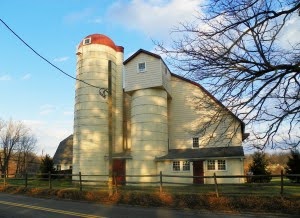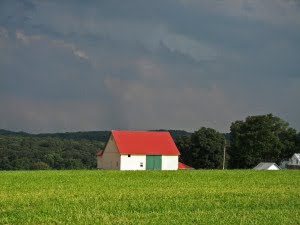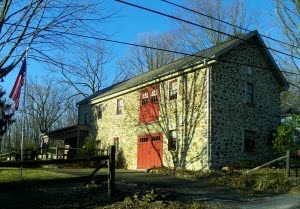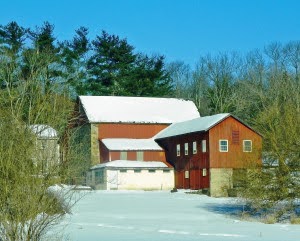Barn Voyage! – Central Bucks County
Unwind as you drive down the picturesque back roads of Bucks County, and take notice of the beauty around you. Bucks County’s history and heritage is deeply rooted in its landscape, and we are fortunate to have much of it still intact. This series of self-guided driving barn tours of Bucks County will help you to explore our truly unique countryside while learning about its history along the way. Many of our “castles in the fields” stood witness to the American Revolution and the founding of this country. Whether they are still being used on working farms or adaptively reused as houses or offices, barns remain relevant fixtures and guardians of the history of our county and country.
Listen to local historian Jeff Marshall (Heritage Conservancy’s former president) talk about a fascination with barns and the importance in preserving them.
We hope that by learning about and recognizing the beauty of these barns, you will be inspired to help protect them. Enjoy discovering the story of Bucks County through these iconic structures. Barn voyage! Please remember: most barns featured on this tour are privately owned, so enjoy them from a distance!
This tour was made possible thanks in part to funding from Visit Bucks County.
Print out turn-by-turn driving directions to embark on this self-guided driving tour.
NOTE: Some of the following addresses are not exact, but they will get you in the general vicinity of the barn. Because many barns were built across from their respective houses, it can be difficult to determine a barn’s address! You will need to rely on your observation as well as your navigation.
Use hashtag #barnvoyage when posting on social media!

Barn 1: Thompson-Neely Barn
Across from Bowman’s Hill Wildflower Preserve at 1632 River Road
New Hope, PA 18938
Built in the early 1700s, the Thompson-Neely barn is quite unique. Unlike most barns, it was built with two stories on the rear elevation but only one story on the barnyard side. This gives the barn a saltbox configuration when viewed from the gable ends. The barn is a three bay English barn with double wagon doors in the central bay on both elevations. The double doors on the barnyard side are flanked by single doors; one door is larger than the other. The reason for this feature is generally consistent with a larger door being used for horses and a smaller door for cows. The barn has narrow ventilation slits in the haymows. The Thompson-Neely House was used as a hospital for sick and wounded soldiers during the Revolutionary War just prior to George Washington’s famous crossing of the Delaware River on Christmas night. It is believed that after the first Battle of Trenton, James Monroe was brought here. The Thompson-Neely House is open for tours.
The “a-bridged” version of the tour takes you through one of Bucks County’s historic covered bridges:
Van Sant Covered Bridge
266-298 Covered Bridge Road
New Hope, PA 18938
Located in Solebury Township, the Van Sant Covered Bridge was built in 1875 and crosses the Pidcock Creek. It is 86 feet long and 15 feet wide. It was added to the National Register of Historic Places on December 1, 1980. For more information about the 10 Bucks County covered bridges that you can still drive through, go to www.visitbuckscounty.com/things-to-do/driving-tours/covered-bridge.

Barn 2:
250 Lurgan Road
New Hope, PA 18938
While the original date of construction is unknown, according to family accounts, this barn’s roof was raised and converted to a gambrel roof in 1917. Two wings were added to the barn in the 1950s & 60s, and a concrete stave silo was built in 1955 to add more space than the earlier wooden silo. Perhaps the most unique feature of this barn is the gable roof structure at the top of the older silo.

Barn 3:
390 Pineville Road
Newtown, PA 18940
This early 19th century structure is a traditional bank barn. It is a stone barn with frame gables. There are several frame additions, including bankside sheds, giving the barn a saltbox appearance. Attached to one end of the barn is a smaller hay barn built with stone stabling, frame-above vertical wood siding and a gable roof.

Barn 4:
359 Pineville Road
Newtown, PA 18940
This stone bank barn was built in two sections. The barn is unique as a double, double-decker barn. The original westerly section of the barn was constructed in 1807. It is a double-decker (interestingly, this means a three-level structure) stone bank barn with pronounced red sandstone quoins on all four corners.
Upon construction of the larger, deeper, easterly addition in 1835, additional stonework was added to the first section, and the barn was raised to allow for a unified ridgeline for both barns. This alteration, which is clearly visible in the west gable, creates an uneven gable roof on the original section. Two louvered ventilators are located on the raised portion of the southerly façade just under the roofline. The space surmounting the threshing doors is frame, rather than stone.

Barn 5:
1085 Durham Road
Newtown, PA 18940
This barn is best viewed seasonally when the farm market is open. This is an example of a simple structure. It is a frame ground barn with small shed additions. What makes the barn interesting is that we know the story of its construction. Knowing the story of a building helps us to see a barn as a representation of the lives of those who owned it and it helps to make the barn more than a simple inanimate object.
Following a fire in 1914, George L. Eastburn had contractor John K. LaRue build the barn that you see today. Along with the original barn, George L. Eastburn lost his hay houses, wagon house, four corncribs, machine house, chicken house, and other small structures and their contents in the fire. The barn contained 30 tons of baled hay, 15 tons of loose hay, 800 bushels of oats, a loaded hay wagon, thresher and cleaner and other machinery, and ten tons of fertilizer. With the wagonhouse went a market wagon and Benjamin Eastburn’s automobile, and with the cribs, 175 bushels or more of corn were destroyed, resulting in a loss estimated at $6,000. The newspaper reported that as many as a thousand people were at the scene during the afternoon and evening, many of whom assisted in every way they could in checking the flames and removing articles from burning or threatened buildings.

Barn 6:
5801 Ridge Road
New Hope, PA 18938
Ridge Road represents one of the largest collections of preserved farms in Bucks County; therefore, many of the barns are still in use as agricultural facilities surrounded by agricultural land. Of particular note is the barn at 5801 Ridge Road. This yellow and green barn with its red roof is one of the most dramatic barns on the tour. This bank barn has a symmetrical frame superstructure that projects over the stable doors, forming a sheltered area on the opposite side of the bank. (This is not visible from the road. Remember: Most barns are private property.)

Barn 7:
1418 Street Road
New Hope, PA 18938
(across from 1301 Street Road)
You will pass barns on both sides of the road. The first barn on the left is part of the agricultural preservation area. It is a typical 19th century bank barn with an extended forebay. Unlike many barns in the county, this one is still actively used for agriculture. The pictured barn at 1418 Street Road is a residential conversion of an English barn. It is similar to several others on the tour in that it is a solid stone, three bay, ground barn. The presence of several on the tour belies how rare this style of barn is in Pennsylvania.

Barn 8:
1301 Street Road
New Hope, PA 18938
A hay bale’s throw from the barn at 1418 Street Road, you will find the barn at 1301 Street Road. This barn shows just how much these structures can evolve and grow over time. The core of this complex barn is a standard stone barn with frame gables. The forebay elevation has a barnyard “L.” A two-story frame shed and one-story masonry addition fill the area between the main barn and the “L.” There are also sheds on the bank side. A more modern stable area has been added to the side away from the road.

Barn 9:
5441 Ash Road
Doylestown, PA 18902
The core of this structure is a large, full-stone barn mirroring barns found in the English Lake District. Unlike the traditional Pennsylvania German barn, this barn had no forebay extension on the barnyard elevation. However, like many Pennsylvania barns, this structure is quite large, with the stabling on the lower level and the threshing area and hay storage above. Access to the upper level was via an earthen bank or hill, giving these barns the name “bank barns.” The west end of the barn clearly shows the scar of a former addition that may have been an open animal or equipment shed. The barn has a large stone wall that encloses the barnyard with a lower stone and wood frame wing. Although the date of this barn is not verified, it appears to date from the early-19th century. To see this barn, you may have to turn off the route for a few yards.

Barn 10:
2855 Ash Mill Road
Doylestown, PA 18902
This barn has been converted to a residence. The most interesting feature of the barn is the trio of stable-level doors on the gable end that faces the road. Each has a gable hood with a scalloped bottom. Traditionally, these doors led into feed aisles or individual stalls. This style of barn is generally found in the last quarter of the 18th century through the first quarter of the 19th century.

Barn 11:
3171 Ash Mill Road
Doylestown, PA 18902
The classic stone work of this barn makes it stand out. This barn appears to date from the early-19th century with many later additions. The main barn is a three bay bank barn that no longer has a bank. The central bay of the barn on the visible northerly side is of frame construction above the stable level. This suggests that the barn originally had an earthen bank leading up to the barn doors in the central bay of the barn. These doors would have originally opened to allow hay wagons to enter the upper level of the barn. The barn has a large stone perpendicular “L” wing projecting from its corner. This wing serves to help define the barnyard. Please remember: most barns featured on this tour are privately owned, so enjoy them from a distance!

Barn 12:
3447-3451 Street Road
Doylestown, PA 18902
The largest building on this property is a stone barn with a 1796 date stone in the gable. This barn is highlighted by keystone lintels above the windows in the gable end. The window openings are protected with wooden louvers rather than narrow ventilation slits seen on other stone barns. The barn has several stone and frame additions on the barnyard facade and the easterly gable end. A stone springhouse is located well to the north of the remaining farmstead. Historic documentation suggests that this springhouse may relate to an even earlier farmstead. The owner of the then 200-acre property when the barn was constructed was John Holcombe, a local Quaker who served as Lieutenant in the American Revolution and whose grandfather owned a large part of present-day Lambertville, NJ.

Barn 13:
6066 Sawmill Road
Doylestown, PA 18902
Like many Bucks County farms, this 19thcentury barn is now separated from the house by a public road. Many think this was done because early roads were extensions of farm lanes. The core of this barn is a full stone structure that was supplemented by frame-over-stone shed wings. The core has three Dutch doors in the gable, providing access to the stable level. Generally, these doors led to both individual stalls and long feed aisles. The front and rear walls of the barn are now obscured by later shed roof wings added to provide additional storage space.

Barn 14:
3465 Aquetong Road
Doylestown, PA 18902
This barn is an example of a single-level barn, which is often referred to as an English-style barn to differentiate it from the Pennsylvania German influenced two-level bank barn. Here, the central bay on the north elevation is of frame construction, while the end bays and gable ends are stone. The south elevation, which is not clearly visible from the road, is stone with double wagon doors in the central bay. It shows evidence of a former pent roof across the façade. The need for large doors on the north side to accommodate loaded hay wagons influenced this design. The unloaded wagons could then proceed out the smaller doors on the opposite elevation. There is a gable wing with a shed extension to the east of the main barn. It most likely dates to the last quarter of the 18th century or the first quarter of the 19th century.

Barn 15:
6370 Greenhill Road
New Hope, PA 18938
This is an outstanding collection of 19th century vernacular farm buildings. According to a stone carved on the south elevation, the main part dates to 1811. This property remained in the Balderston family from 1766 until 1927, when 128 acres were sold.
This farm is prominently situated on a hill near the intersection of Greenhill and Mechanicsville Roads. The buildings can only be seen at a distance. There are three barns on the property, one of which is a stone barn with a frame threshing area and is highlighted by ventilation slits that have been partially converted to residential use. There is an unusually long stone barn with a slightly projecting frame forebay and several large wall dormers for access to granaries. This second barn is extremely unusual in that it is quite long and narrow; it is without precedent in Bucks County. 19th century advertisements suggest that this was a “cow house” rather than a typical grain and stabling barn. The third barn is a frame bank barn that was moved to the site and placed on the foundations of another barn. Other buildings on the site include a stone piggery, stone smoke house, vault, and frame double corncrib. These buildings are only visible from a distance along the route. A side-trip down Greenhill Road will provide a better view.

Barn 16:
3361 N. Sugan Road
New Hope, PA 18938
This barn is a classic example of a single story English barn. This type of barn was generally superseded in this region by the two-level German-influenced “Pennsylvania Bank Barn” by the early 19th century. However, in central Bucks County, specifically in the area surrounding New Hope, Pennsylvania, there remain a number of barns that pre-date the classic Pennsylvania barn.
This is a three-bay barn. The central bay (original threshing floor) appears to have been originally wood frame construction. The barn features two doors in the gable end of the east gable with a wider one providing access to a horse stable. There are no doors on the opposite gable end of the barn; the access to the stable area in this end of the barn is on the barnyard elevation.
There is in the interior of the east gable (facing the house) a date stone with the date of 1786. The unusual location of the date stone most likely is due to the fact that someone added a large window in the gable. Presumably the window was installed where the original date stone was located and the stone was rescued and relocated below the window on the interior. Many of current window openings which are now glazed were originally protected by wooden louvers. The frames still show the tenons where the original louvers would have been installed in the frames.

Barn 17: Bucks County Audubon Society at Honey Hollow Visitor Center
2877 Creamery Road
New Hope, PA 18938
Preserving the barn’s original characteristics, which include four out sheds, oversized doors, the “people” doors, and the interior space, the Bucks County Audubon Society (BCAS) converted the barn to house its nature shop, an environmental education classroom, displays, and a discovery room for children.
The barn was designed by renowned architect, R. Brognard Okie, who was known for his colonial restorations, which include the Betsy Ross House and Pennsbury Manor. Built in 1934, the barn provided cool, dry storage for grain, straw, and hay as well as horse stalls. In 1994, BCAS acquired the barn along with 55 acres. The renovation of the barn was completed in 1998. Historic photographs and information are on display. The property is located on land that is protected by a conservation easement administered by Heritage Conservancy. BCAS often holds public events, so feel free to get out and explore this barn and its surrounding area.

Barn 18:
2725 Aquetong Road
New Hope, PA 18938
This farmstead is an excellent example of mid-18th century architecture. During the Revolutionary War, the property was an encampment site of General Charles Lee’s army. The brigades encamped at Rolling Green Farm preceded General Washington’s march from Valley Forge to Monmouth. A Continental soldier from a southern state grew ill and was nursed here by the Paxson family, a distinguished family residing in Bucks County from its earliest settlement. The soldier died and was buried on the property.
The original section of the low barn has a central door and long ventilator slits and is probably contemporary to the first section of the house that dates to 1748. The English three-bay stone barn is highlighted by narrow ventilation slits.
According to several date stones, the original section of the house was built by Enoch Pearson in 1748. The original stone section of the barn was probably built around the same time, making it one of the oldest barns in Bucks County. The current owners renovated the barn, replacing the old asbestos siding with wood siding. Inside, a floor was constructed for the adaptive reuse of the barn.

Barn 19: New Hope Winery
6123 Lower York Road
New Hope, PA 18938
This mid-19th century frame-over-stone bank barn has been converted for retail use as a winery. Unlike most barns, the bank is on the southerly side of this barn. Generally, the bank was located on the back of the barn. Most barns had ground-level stable doors on the south or southeasterly side so that the animals could benefit from the morning sun. These doors were sheltered by either being recessed from the frame superstructure above or protected by a projecting frame forebay. This winery is part of the Bucks County Wine Trail. For a full list of wineries on the trail, visit www.visitbuckscounty.com/listings/Bucks-County-Wine-Trai
Bonus Barns
A. 645 Pineville Road
Newtown, PA 18940
An English barn
B. 1190 Eagle Road
Newtown, PA 18940
An English barn converted to a forebay barn
C. 5113 Anderson Road
Doylestown, PA 18902
This bank barn is currently a private art studio
D. 3539 Holicong Road
Doylestown, PA 18902
A Pennsylvania bank barn
E. 6355 Pidcock Creek Road
New Hope, PA 18938
A four bay barn
F. 3070 River Road
New Hope, PA 18938
A double-decker barn
Other Places to Visit
Bowman’s Hill Wildflower Preserve
1635 River Road
New Hope, PA 18938
Located down the road from the Thompson-Neely barn, Bowman’s Hill Wildflower Preserve showcases an extraordinary diversity of plants native to Pennsylvania and the Delaware Valley region. Of the approximately 2000 species native to Pennsylvania, the Preserve is home to nearly 800 of them. The goal of the Preserve is to encourage the public to visit, enjoy, and learn about the richness of Pennsylvania’s natural heritage.
Bucks County Wine Trail
Experience the rich heritage behind the wines expertly crafted by the family wineries of Bucks County. The gentle rolling hills, deep well-drained soils, and moderate climate combine to make Bucks County one of the premier grape-growing regions of the East Coast. See how wine is produced. Talk with the people who make it happen. Tour the cool wine cellars. Experience history in the making. For the list of wineries, visit www.visitbuckscounty.com/listings/Bucks-County-Wine-Trail
Covered Bridge Tour
This tour of Bucks County’s 12 remaining covered bridges starts at the Memorial Building in Washington Crossing Historic Park on the Delaware River. The Tour makes a large circle through Bucks County and is planned so the traveler can start at any one of the bridges. For directions, visit www.visitbuckscounty.com/about-bucks-county/maps/covered-bridge-tour-directions
New Hope & Ivyland Railroad
32 West Bridge Street
New Hope, PA 18938
Climb aboard the New Hope & Ivyland passenger train and travel into a scene from the past. Relax and leave your cares behind as you journey into history, learning what rail travel was like for your parents, grandparents or great-grandparents.
New Hope, PA
Nestled along the banks of the Delaware River, the village of New Hope and its surrounding area offers visitors scenic countryside, romantic hideaways, and family fun. This sophisticated yet country-casual town provides a much-needed break from today’s hectic lifestyle and offers something for everyone.
Peddler’s Village
Routes 202 & 263
Lahaska, PA 18931
Discover a historic village with charming colonial-style buildings, award-winning gardens, and distinctive shopping, dining, and lodging. For more than 50 years, visitors have followed the winding brick pathways to experience exceptional dining, explore the best of Bucks County shopping, enjoy family fun at Giggleberry Fair, escape from the everyday to a getaway at the Golden Plough Inn, and celebrate favorite traditions at seasonal festivals and annual events.
Washington Crossing Historic Park
1112 River Road
Washington Crossing, PA 18977
From this site, General George Washington and men of the Continental Army and militia crossed the Delaware River on Christmas night 1776 and marched to Trenton, NJ. There, they attacked and defeated Hessian troops quartered in and around the village. This surprise attack and victory set the stage for Washington’s subsequent victories at the Second Battle of Trenton and Princeton.